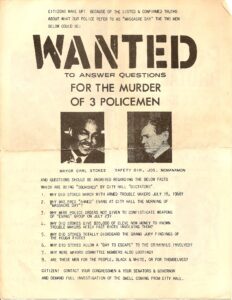Ohio Archives Month Spotlights: Cleveland Police Historical Society and Museum
The Society of Ohio Archivists Advocacy and Outreach Committee is happy to announce that we will be spotlighting archives around the state again this year to celebrate archives month throughout October 2023. Each of our archives spotlights will feature places that house materials related to the theme of the poster, Land, Water, & Air: Transportation in Ohio.
by Christine Liebson, MLIS, CA
Introduction
The Cleveland Police Historical Society and Museum exists to collect and preserve Cleveland police history and to use its collection and programs to educate the public and to foster a mutual understanding and respect between law enforcement and the public. The Cleveland Police Historical Society (CPHS) works in cooperation with, but is independent of, the Cleveland Division of Police. Financial support comes from membership dues, donations, and small grants from various government agencies and private organizations. The CPHS receives no tax funds from the City of Cleveland, State of Ohio, or the Federal Government. The Cleveland Police Museum opened in June 1983 with Florence E. Schwein as its director. The current director, Mazie Adams, graciously accepted our invitation for an interview to share with us about her work and collections at the museum.
Interview with Mazie Adams, Director
CL: What drew you into the archival/museum studies field?
MA: I have always liked history and going to museums. After studying history as an undergraduate at Kenyon College, my professional interests evolved from teaching history to museum education, which led me to earn a master’s degree in museum education at The George Washington University. Prior to my current position, I have worked at historic houses, for other historical societies, and as a local history consultant.
CL: What do you like most about working at the Cleveland Police Museum?
MA: I love working in small organizations and enjoy being able to do a wide variety of tasks. In my role here I am able to be a “jack of all trades” with curatorial, educational, and management responsibilities. With a supportive board of directors, it is possible to also have a lot of autonomy in my work.
CL: Could you describe the scope and size of your archival collections? What kinds of records form the archive?
MA: The museum’s collections include 3-d artifacts, a substantial photograph collection, library materials and archival materials including certificates, reports, notebooks, letters, ledgers and scrapbooks from prior police personnel. Our facilities footprint originally consisted of 1200 sq. ft. of space on the first floor of Police Headquarters in the Justice Center. It has since grown to 7,000 sq. ft. of exhibits, offices and storage. The museum features exhibits that document the history of the Cleveland Police from its inception in 1866. Our collections are very specific to police work, such as our Oath of Office Books, which contain detailed information about our officers, including the date they joined, their badge numbers, their previous jobs, and sometimes their date of retirement. With the upcoming relocation of Cleveland Police Headquarters, we will probably be moving to a new facility.
CL: Do you have a favorite item or story from the archives?
MA: Our collection covers topics that police deal with every day, which can often be gruesome or technical, but when presented through a historical lens can help us reach a broader audience. Our exhibits allow us to tell stories of policing, which in turn gives insights into Cleveland history. We have the only known artifacts relating to Cleveland’s notorious Torso Murders in the 1930s. While researching our exhibit on the Torso Murders, we discovered new archival materials from the CPD’s Criminal Investigation Unit that provided context for original crime scene photos. It was great to find new items related to this very popular topic.
CL: I found the recently published CPHS Hot Sheet articles, “We must never forget, The Tragedy of Glenville, July 23, 1968” and “Glenville, Cleveland’s Bloodiest Day, As Seen Through The Eyes of a 15 Year Old” especially interesting. Could you tell me a little more about them?
MA: This is a story that is so connected with social unrest and injustice happening in the 60’s and an example of how our materials not only tell the story of what it was like to be an officer at a given time but also the historical context for the broader community. This was the deadliest day in Cleveland Police history, with three officers killed and 13 others severely injured. Our exhibit includes the uniforms they wore, the weapons they carried, and helps bring to the forefront issues that boots on the ground police faced. One of the pieces we have related to the event is an unofficial “wanted” poster for the Cleveland Mayor and Safety Director at the time created by police because they felt they went into the situation unprepared. But our exhibit also places these items and the Glenville tragedy into the broader history of Cleveland’s social and economic past. It’s a large, complicated story that was a challenge to tell well.
CL: What is the most interesting research question you have received in regards to Cleveland Police history?
MA: One research question I found very interesting was from someone with a personal magic museum collection researching Harry Houdini and his performances in Cleveland. Houdini would do “police challenges” in which he would be put in various restraints and then he would escape. As part of the research, I am helping to corroborate these stunts, one of which was at the old police headquarters on Champlain Street (which was torn down for the Terminal Tower complex). It can be super fun to do crossover research like this. We also recently shared materials that helped support cold case investigations and work of the Cleveland Law Department.
All image courtesy of Cleveland Police Historical Society and Museum. Follow them on Facebook.
Last Updated on November 3, 2023 by Emily Gainer



